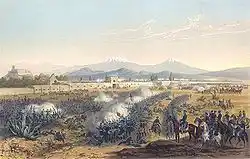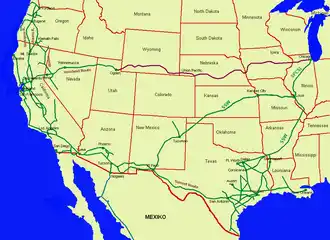The Gadsden Purchase was a significant territorial purchase which the United States made from the government of Mexico in 1854. It is named after the US Minister to Mexico at the time, James Gadsden, who negotiated with the Mexican government. The land involved covered just over 75,000 square kilometers, primarily across the south of what subsequently became the state of Arizona, as well as a smaller pocket of land in the southwest of New Mexico. The lands involved are significant in so far as the city of Tucson and other urban centers like Yuma and Sierra Vista lie there today. The territory was sought by the US government as it lies along a westwards passage which was being eyed as a potential route for a railroad to California at that time, even in the early days of the American West. It would take until the early 1880s before it was completed, but eventually the Sunset Route of the Southern Pacific Railroad would be established along the lands acquired as part of the Gadsden Purchase. The region opened up to significant migration in the US in the process. Around two million people live in the lands involved today, with roughly one million alone in the Tucson metropolitan area.[1]
Research your ancestors on MyHeritage
Gadsden Purchase chronology of eventsGadsden Purchase chronology of events
Prior to the Louisiana Purchase of 1803, the United States was a country that was largely confined to the East Coast and some lands further inland towards the Great Lakes and on the other side of the Allegheny Mountains. The Louisiana Purchase of a huge swathe of land from France that extended all the way from the Dakotas in the north south to Louisiana and Mississippi in the south extended the country dramatically westwards. From this point onwards the idea of Manifest Destiny emerged, that the United States was logically meant to expand westwards until it reached the Pacific Ocean, becoming a trans-continental nation.[2]

This involved disputes with the British over lands in places like the modern-day states of Montana and Washington, but it primarily focused on trying to displace the Native American peoples from these lands and also acquire territory stretching from Texas to California from the Mexican government after that country emerged from under Spanish colonial rule in 1821 after the lengthy Mexican War of Independence. During the 1820s and 1830s the US government was still focused on settling lands in the Midwest and places like Alabama before expanding further west. Nevertheless, tensions were already brewing in Texas and a Republic of Texas emerged there in 1836 with a more pro-Washington, than pro-Mexico City outlook.[3]
The eventual annexation of Texas by the US in 1845 led to a dispute over where the border with Mexico lay. This was escalated in April 1846 into the Mexican-American War. During it, the US won a decisive victory, invading Mexico and taking its capital in 1847. In the ensuing Treaty of Guadalupe Hidalgo of February 1848, Mexico ceded a very large tract of territory to the United States. This comprised lands stretching from Texas all the way west to California and southern Oregon. It included what would subsequently become the states of New Mexico and Arizona. The end of the war also led to the opening of the American West with the inception of the California Gold Rush and as the newly devised steamships began bringing hundreds of thousands and then millions of Europeans to North America every decade.[4]

The Gadsden Purchase came about owing to the desire of the US government to acquire an additional strip of territory along the new southern border. The agreement reached in 1848 had fixed the border in the south of what would become the state of Arizona largely along the course of the Gila River. This was problematic. It quickly became apparent to planners in Washington that if a railway line were ever to be built going directly west from the southern parts of the Rio Grande in Texas towards California, it would run into the Gila River and Mexico. Thus, when the military officer, James Gadsden, was appointed as the US Minister to Mexico in 1853, he was sent with orders to try and negotiate the purchase of some lands south of the Gila River that would solve the problem.[5]
Through the Treaty of Mesilla, signed in December 1853, and which came into effect in the summer of 1854, Gadsden managed to have Mexico sell the lands in question, with the US government paying ten million dollars, a sum equivalent to around $350 million in modern terms. The land involved was not much more than 75,000 kilometers. Today this primarily lies in the southern part of Arizona, with a small pocket as well in south-western New Mexico. It was not until the early 1880s that the Sunset Route of the Southern Pacific Railroad was finished running through the lands involved and serving to complete the connection of Texas to California by rail.[6]
Extent of migration and demographic impact of the Gadsden PurchaseExtent of migration and demographic impact of the Gadsden Purchase

The Gadsden Purchase did not lead to a large deluge of individuals into the lands of the Gadsden Purchase overnight. It was a gradual process that was initially aided by the establishment of mail coach and stage coach routes running from Texas all the way through southern New Mexico and Arizona through Tucson and on to Yuma.[7] A major bout of migration followed in the late 1870s as Tombstone became the latest center of a mining rush in the American West, this time in search of silver.[8] The railway arrived in the 1880s and the lands here became more law-abiding, although it was still 1912 before Arizona would be made the 48th state and the last to be created in the contiguous, continental United States. Over time Tucson emerged as the major city here and today is the second largest in the state, with a population of over a million people in the wider metropolitan area. It is one of the country’s fastest growing cities.[9]
See alsoSee also
Explore more about the Gadsden PurchaseExplore more about the Gadsden Purchase
- Arizona Newspapers, 1866-2009 records collection on MyHeritage
- Arizona Birth Certificates, 1887-1935 records collection on MyHeritage
- Arizona, Births and Christenings, 1909-1917 records collection on MyHeritage
- Arizona, Marriages, 1888-1908 records collection on MyHeritage
- Arizona Death Certificates records collection on MyHeritage
- Arizona, Deaths and Burials, 1910-1911; 1933-1994 records collection on MyHeritage
- Arizona, Biographical Database records collection on MyHeritage
- Researching Arizona Ancestors at Legacy Family Tree Webinars
References
- ↑ https://history.state.gov/milestones/1830-1860/gadsden-purchase
- ↑ https://www.historytoday.com/archive/months-past/manifest-destiny
- ↑ https://www.tshaonline.org/handbook/entries/republic-of-texas
- ↑ https://www.pbs.org/wgbh/americanexperience/features/grant-mexican-american-war/
- ↑ J. Fred Rippy, ‘The Negotiation of the Gadsden Treaty’, in The Southwestern Historical Quarterly, Vol. 27, No. 1 (July, 1923), pp. 1–26.
- ↑ Louis Bernard Schmidt, ‘Manifest Opportunity and the Gadsden Purchase’, in Arizona and the West, Vol. 3, No. 3 (Autumn, 1961), pp. 245–264.
- ↑ https://thegracemuseum.org/learn/2020-7-23-smiths-station-on-the-butterfield-overland-stagecoach-line/
- ↑ Jeanne Devere, ‘The Tombstone Bonanza, 1878–1886’, in Arizoniana, Vol. 1, No. 3 (Fall, 1960), pp. 16–20.
- ↑ https://mapazdashboard.arizona.edu/workforce-demographics/population-profile

